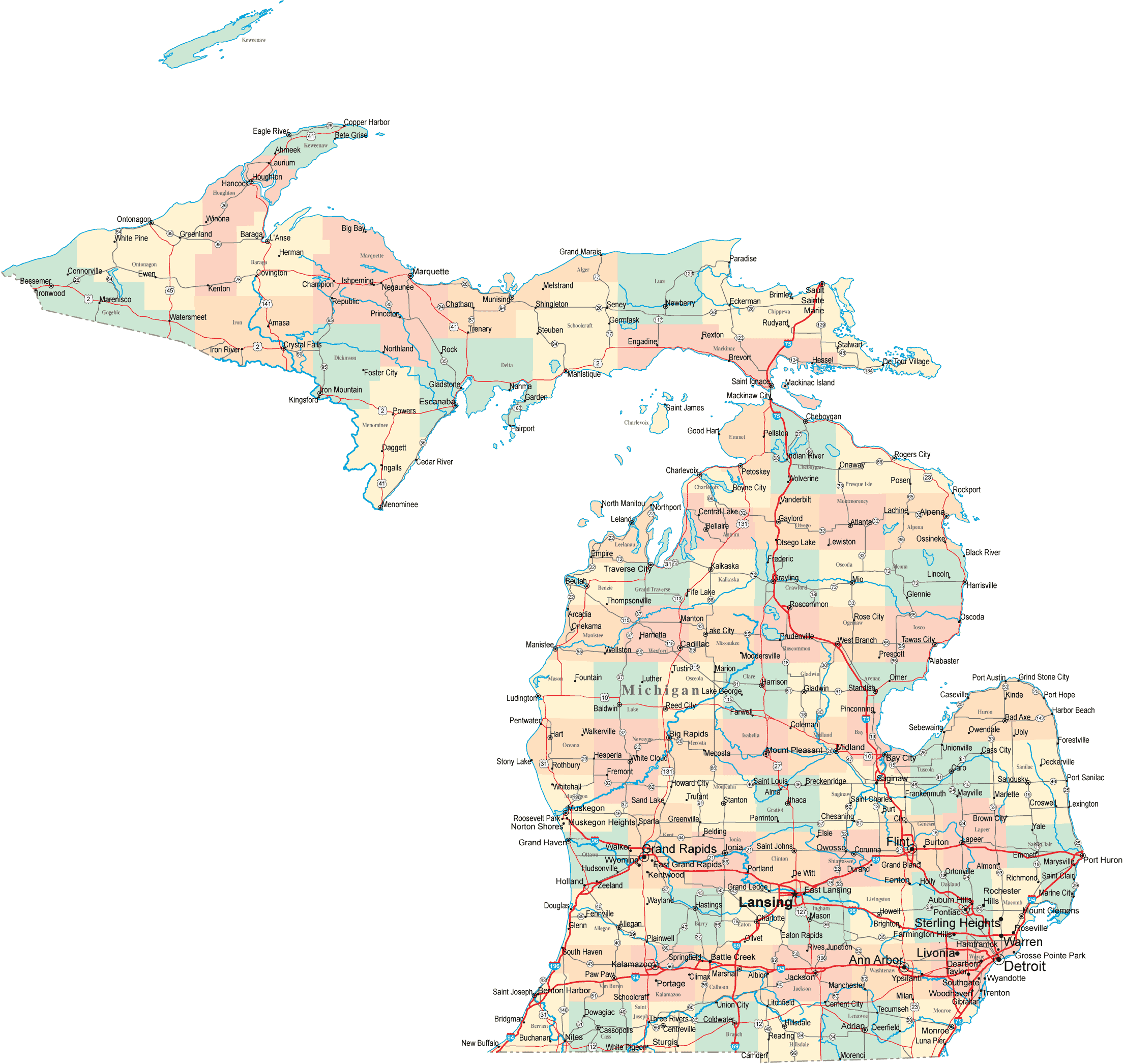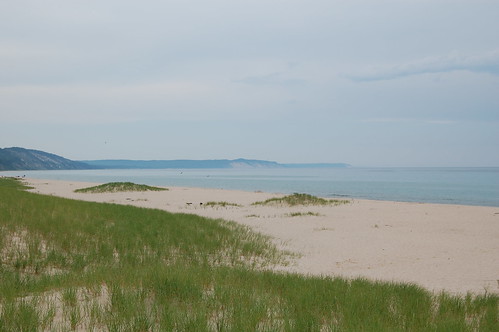Blue Highways: Elberta, Michigan
Unfolding the Map
 Big sand dunes can be found at the shoreline of northeastern Lake Michigan. I will relate my own experiences there, and my impressions of sand dunes in general. Sounds like a rockin' time, doesn't it? Perhaps you'll find it interesting, perhaps not, but in any event it's our first Blue Highways stop in Michigan. To see where William Least Heat-Moon (LHM) disembarks, take some steps to the map.
Big sand dunes can be found at the shoreline of northeastern Lake Michigan. I will relate my own experiences there, and my impressions of sand dunes in general. Sounds like a rockin' time, doesn't it? Perhaps you'll find it interesting, perhaps not, but in any event it's our first Blue Highways stop in Michigan. To see where William Least Heat-Moon (LHM) disembarks, take some steps to the map.
Book Quote
"The sandy dunes of Michigan glowed pink in the late sun, and at the mouth of the Elberta Harbor, there was a marvelous sight: little slivers of silver jigged on their tails over the blue water. They were alewives looking for all the world like dancing spoons. These were the fish that had washed ashore to foul beaches in the days of high pollution.
"The Viking let loose with her horns, the crew tied up and sprinted across the dock and into cars and roared off to supper, and I wished the Viking were sailing all the way to the Atlantic."
Blue Highways: Part 7, Chapter 13
 Lakeshore beach at Elberta, Michigan. Photo by mr56k and hosted at Flickriver. Click on photo to go to host site.Elberta, Michigan
Lakeshore beach at Elberta, Michigan. Photo by mr56k and hosted at Flickriver. Click on photo to go to host site.Elberta, Michigan
Sand dunes, or rather one big sand dune, is a big memory of the times I spent in Michigan.
When I was just out of college, I joined an organization called the Jesuit Volunteer Corps. While I was placed as a volunteer in Milwaukee, Wisconsin we had an opening retreat in Benton Harbor, Michigan so that we could meet the other volunteers in the region - some of whom would be my housemates for a year - and get into the mission of the volunteer organization. At the end of the year, the organization hosted a final retreat in Traverse City, Michigan so that we could wind down, say goodbye to our housemates and the other volunteers, and move on into the rest of our lives.
The thing I loved about the eastern side of Lake Michigan is that, of all the other places I've visited in the U.S., it most reminded me of my oceanside hometown in Northern California. Of course, in the summer the weather was much warmer, and the lake waves were much smaller compared to the roaring surf of the Pacific Ocean. In other respects, however, they were very similar. The shore along Lake Michigan has the same feel, the sun set over the lake waters, and the sand dunes blown up by the prevailing western winds were very reminiscent of the dunes in places along the Northern California coast. I would consider living there as a substitute for the west coast of the United States.
It was while at my first retreat in Traverse City that I first visited Sleeping Bear Dunes National Lakeshore, which is a mere half hour away from where LHM disembarked from The Viking in Elberta. Since he mentions sand dunes in his quote, it is a shame that he didn't visit the place. This particular set of dunes rises 150 feet high from the lake and has an interesting story. The Ojibwe believed that a mother bear and her cubs, fleeing from a forest fire on the west side of Lake Michigan, started swimming across the lake. The mother bear reached the eastern shore and waited for the cubs. The cubs however, too exhausted, drowned within sight of the shore. The two islands in sight of the dunes, North and South Manitou Islands, are believed to be the cubs. The mother bear, who continued to wait for the cubs, fell asleep and eventually was covered by the sands. Under the Sleeping Bear Dunes she continues sleep and wait.
When you stand at the top of the dunes, the lake looks very far beneath you. You start down and gravity just tugs at you. When I scrambled down, I realized that once you get going, you start taking big leaps and bounds, covering 15 feet per step. It's almost like being on the moon, except that the slope is about 60-75 degrees. Of course, sand gets into your shoes, but it's so fun getting down you don't care.
However, if you go, I must caution you that it can be dangerous to get going too fast. Gravity, the attraction that two bodies have for each other (in this case you and Earth) and inertia, the property of bodies to remain in either a state of motion or rest, work together to make it very difficult to stop if you get going too fast. Your loss of balance will make your moving body collide with the sand at a fast rate of speed and if you're lucky you won't be hurt. I knew a young woman who lost control on her way down and cracked her head on a rock buried under the dune's sands. She split her head open and had to be accompanied back up by paramedics. So be careful when you do your moon-bounding thing on Sleeping Bear Dunes!
Coming back up, however, is a real difficulty. Climbing a 150 foot, 60-75 degree-sloped sand dune really gets your breath going in short gasps, your leg muscles sore, and your heart pumping so hard it feels like it might burst out of your ribcage. What took you five minutes to get down takes fifteen to get back up, if you add in the stops for rest. At the top, you almost feel like you've run five miles in that combination of exhiliration that you made it and extreme tiredness.
To me, dunes represent the same type of wave action that governs water except on an infinitely slower pace. A time lapse photo of the dunes of the Sahara Desert, sped up to normal time, would resemble waves of an ocean in their windswept journey. The edges of the dunes would lap at, and sometimes inundate and then retreat from, the areas at the edge of the desert borders. If you stand at the top of a dune, you are really on the crest of a giant sand wave that is slowly, infinitesimally, moving and cresting. It is a beautiful contrast between the liquid wave motion of water and slow, particulate wave motion of sand or other materials.
I write "other materials" because dunes are not just waves of sand. The beautiful white dunes of White Sands National Monument in New Mexico are composed of gypsum particles, not sand. A dune, no matter what it is made of, can cover a lot of ground in its slow movement. The 600 foot high Sand Mountain in Nevada, a previous subject in the Blue Highways posts, has apparently moved back and forth across the desert floor for some generations, following the whims of the prevailing winds. It also "sings" due to the shape of its sands. There are other singing dunes too, as this fascinating video by Stephane Douady demonstrates.
Wherever there is wind and small particles, you'll find dunes. They have helped create some of the great rock formations that we see in the western United States. They are also otherworldly. Giant dunes exist on Mars, and Venus and Saturn's moon Titan also have named dune fields. I used to see dunes as being iconic symbols of the desert, and we still tend to associate them with desert areas. They are much more than that, however, and their achingly slow, shifting, and relentless march across all regions of the world, past and present, make them an ever-present part of external and internal landscapes.
Musical Interlude
I know some other good reasons for dunes. "If you like making love at midnight, in the dunes on the cape," then this song is for you. Get a little "Escape" with Rupert Holmes. (By the way, this song has more words on Wikipedia than some Beatles songs).
If you want to know more about Elberta
Benzie County Record Patriot (newspaper)
Frankfort-Elberta Chamber of Commerce
Village of Elberta
Wikipedia: Elberta
Next up: Mount Pleasant, Michigan




 Tuesday, April 3, 2012 at 10:36PM
Tuesday, April 3, 2012 at 10:36PM